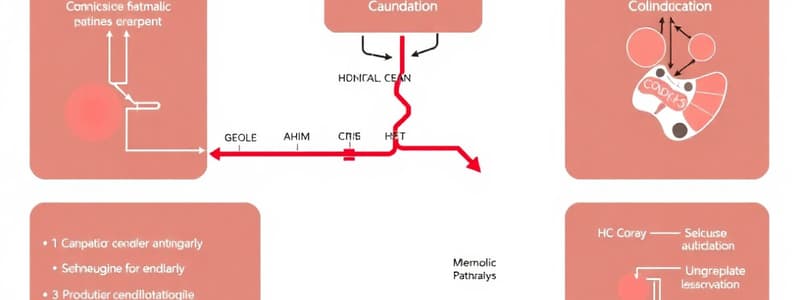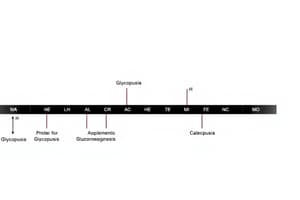Podcast
Questions and Answers
What is the primary role of glucose in metabolism?
What is the primary role of glucose in metabolism?
- To serve as the sole fat storage molecule
- To facilitate rapid muscle contraction
- To generate energy via glycolysis and serve as a precursor for various biomolecules (correct)
- To act exclusively as a precursor for proteins
Which of the following correctly describes the energy yield of glucose oxidation?
Which of the following correctly describes the energy yield of glucose oxidation?
- It requires oxygen for the process
- It produces CO2 without generating H2O
- It generates energy equal to 1000 kJ/mol
- It produces 2840 kJ/mol of energy (correct)
What regulates the amount of glucose in the blood?
What regulates the amount of glucose in the blood?
- Environmental temperature changes
- Tightly regulated processes involving glucose production and consumption (correct)
- Dietary intake only
- Animal behavior and activity levels
What is the significance of glucose as an osmolyte?
What is the significance of glucose as an osmolyte?
Which of the following describes the typical duration of glucose storage in organisms?
Which of the following describes the typical duration of glucose storage in organisms?
What is the primary substrate converted by glucokinase or hexokinase?
What is the primary substrate converted by glucokinase or hexokinase?
Which metabolite inhibits phosphofructokinase-1 (PFK-1)?
Which metabolite inhibits phosphofructokinase-1 (PFK-1)?
What is the final product of the reaction catalyzed by pyruvate kinase?
What is the final product of the reaction catalyzed by pyruvate kinase?
What is the end product of glycogen degradation?
What is the end product of glycogen degradation?
Which of the following enzymes is most commonly associated with a genetic defect in glycolysis?
Which of the following enzymes is most commonly associated with a genetic defect in glycolysis?
What is the effect of high NADPH concentration on the HMP?
What is the effect of high NADPH concentration on the HMP?
Which enzyme is responsible for the reduction of hydrogen peroxide in the presence of glutathione?
Which enzyme is responsible for the reduction of hydrogen peroxide in the presence of glutathione?
In red blood cells (RBCs), what is the primary source of NADPH?
In red blood cells (RBCs), what is the primary source of NADPH?
What is the chemical structure of reduced glutathione represented by?
What is the chemical structure of reduced glutathione represented by?
Which of the following components is produced in the HMP pathway?
Which of the following components is produced in the HMP pathway?
What reaction does glutathione reductase catalyze?
What reaction does glutathione reductase catalyze?
What form of glutathione represents the oxidized state?
What form of glutathione represents the oxidized state?
What role does NADPH play in cellular metabolism?
What role does NADPH play in cellular metabolism?
What does the polyol pathway convert glucose into?
What does the polyol pathway convert glucose into?
Which cells do not require insulin for glucose entry?
Which cells do not require insulin for glucose entry?
What is the consequence of sorbitol accumulation in cells?
What is the consequence of sorbitol accumulation in cells?
What enzyme is implicated in converting glucose to sorbitol?
What enzyme is implicated in converting glucose to sorbitol?
In uncontrolled diabetes, what happens to sorbitol metabolism in certain cells?
In uncontrolled diabetes, what happens to sorbitol metabolism in certain cells?
Which pathway provides an alternative to glycolysis?
Which pathway provides an alternative to glycolysis?
What is the role of aldose reductase inhibitors?
What is the role of aldose reductase inhibitors?
Which of the following represents a complication of sorbitol accumulation in diabetes?
Which of the following represents a complication of sorbitol accumulation in diabetes?
What is the primary purpose of glycolysis?
What is the primary purpose of glycolysis?
What characterizes the preparatory phase of glycolysis?
What characterizes the preparatory phase of glycolysis?
How much energy, in kJ/mol, is released during the overall glycolysis process?
How much energy, in kJ/mol, is released during the overall glycolysis process?
Which enzyme is primarily responsible for the conversion of fructose 6-phosphate to fructose 1,6-bisphosphate?
Which enzyme is primarily responsible for the conversion of fructose 6-phosphate to fructose 1,6-bisphosphate?
What is the energetic efficiency of glycolysis in terms of total energy harvested from glucose oxidation?
What is the energetic efficiency of glycolysis in terms of total energy harvested from glucose oxidation?
Which step in glycolysis is known to be irreversible under cellular conditions?
Which step in glycolysis is known to be irreversible under cellular conditions?
What happens to the energy transfer process in red blood cells during glycolysis?
What happens to the energy transfer process in red blood cells during glycolysis?
Which of the following compounds is produced at the end of glycolysis?
Which of the following compounds is produced at the end of glycolysis?
Which hexokinase is primarily involved in the liver's glycolytic pathway?
Which hexokinase is primarily involved in the liver's glycolytic pathway?
What role do NAD+ and ADP play during glycolysis?
What role do NAD+ and ADP play during glycolysis?
What is a direct consequence of a genetic defect in enzymes involved in galactose metabolism?
What is a direct consequence of a genetic defect in enzymes involved in galactose metabolism?
What causes the Pasteur effect where glucose is consumed rapidly in certain conditions?
What causes the Pasteur effect where glucose is consumed rapidly in certain conditions?
Which product is formed as a result of glucose consumption in hypoxic tumors?
Which product is formed as a result of glucose consumption in hypoxic tumors?
How is NAD+ regenerated under anaerobic conditions?
How is NAD+ regenerated under anaerobic conditions?
What is the role of thiamine in the metabolism of pyruvate?
What is the role of thiamine in the metabolism of pyruvate?
Which of the following is a common consequence of thiamine deficiency?
Which of the following is a common consequence of thiamine deficiency?
Which step in gluconeogenesis involves the enzyme fructose 1,6-bisphosphatase?
Which step in gluconeogenesis involves the enzyme fructose 1,6-bisphosphatase?
What is the primary product of the oxidative branch of the pentose phosphate pathway?
What is the primary product of the oxidative branch of the pentose phosphate pathway?
What role does oxaloacetate play in gluconeogenesis?
What role does oxaloacetate play in gluconeogenesis?
Which process involves the conversion of glucose-6-phosphate into ribose-5-phosphate?
Which process involves the conversion of glucose-6-phosphate into ribose-5-phosphate?
Which condition is characterized by insufficient oxaloacetate transport in gluconeogenesis?
Which condition is characterized by insufficient oxaloacetate transport in gluconeogenesis?
In which conditions does glucose consumption occur 10-15 times faster than normal?
In which conditions does glucose consumption occur 10-15 times faster than normal?
Which enzyme is crucial for hydrolyzing glucose 6-phosphate in gluconeogenesis?
Which enzyme is crucial for hydrolyzing glucose 6-phosphate in gluconeogenesis?
Flashcards
Glycolysis
Glycolysis
The metabolic pathway that breaks down glucose into pyruvate, producing ATP.
Glucose
Glucose
A simple sugar that serves as a primary energy source in organisms.
ATP
ATP
Adenosine triphosphate; the primary energy currency of cells.
Gluconeogenesis
Gluconeogenesis
Signup and view all the flashcards
Pentose Phosphate Pathway
Pentose Phosphate Pathway
Signup and view all the flashcards
Embden-Meyerhof Pathway
Embden-Meyerhof Pathway
Signup and view all the flashcards
Glycolysis
Glycolysis
Signup and view all the flashcards
Preparatory Phase (Glycolysis)
Preparatory Phase (Glycolysis)
Signup and view all the flashcards
Payoff Phase (Glycolysis)
Payoff Phase (Glycolysis)
Signup and view all the flashcards
Activation Energy
Activation Energy
Signup and view all the flashcards
ATP
ATP
Signup and view all the flashcards
NADH
NADH
Signup and view all the flashcards
Pyruvate
Pyruvate
Signup and view all the flashcards
Glucose
Glucose
Signup and view all the flashcards
Irreversible Step (Glycolysis)
Irreversible Step (Glycolysis)
Signup and view all the flashcards
Hexokinase
Hexokinase
Signup and view all the flashcards
GLUT
GLUT
Signup and view all the flashcards
Glucokinase/Hexokinase
Glucokinase/Hexokinase
Signup and view all the flashcards
Phosphofructokinase-1 (PFK-1)
Phosphofructokinase-1 (PFK-1)
Signup and view all the flashcards
Pyruvate Kinase
Pyruvate Kinase
Signup and view all the flashcards
Glycolysis Enzyme Deficiency
Glycolysis Enzyme Deficiency
Signup and view all the flashcards
Glycolysis Regulation
Glycolysis Regulation
Signup and view all the flashcards
Glycolysis Activator
Glycolysis Activator
Signup and view all the flashcards
Glycolysis Inhibitor
Glycolysis Inhibitor
Signup and view all the flashcards
Feeder Pathways for Glycolysis
Feeder Pathways for Glycolysis
Signup and view all the flashcards
Glycogen Phosphorolysis
Glycogen Phosphorolysis
Signup and view all the flashcards
HMP (Pentose Phosphate Pathway)
HMP (Pentose Phosphate Pathway)
Signup and view all the flashcards
NADPH
NADPH
Signup and view all the flashcards
Oxidative Stress
Oxidative Stress
Signup and view all the flashcards
Glutathione
Glutathione
Signup and view all the flashcards
Glutathione peroxidase
Glutathione peroxidase
Signup and view all the flashcards
Reduced glutathione
Reduced glutathione
Signup and view all the flashcards
Glutathione reductase
Glutathione reductase
Signup and view all the flashcards
HMP shut-off
HMP shut-off
Signup and view all the flashcards
Polyol Pathway
Polyol Pathway
Signup and view all the flashcards
Hyperglycemia Effect on Sorbitol
Hyperglycemia Effect on Sorbitol
Signup and view all the flashcards
Glucose Role in Metabolism
Glucose Role in Metabolism
Signup and view all the flashcards
Main Metabolic Pathways (Glucose)
Main Metabolic Pathways (Glucose)
Signup and view all the flashcards
Glucose Dynamics in Organisms
Glucose Dynamics in Organisms
Signup and view all the flashcards
Glycolysis Steps
Glycolysis Steps
Signup and view all the flashcards
Pyruvate Fates
Pyruvate Fates
Signup and view all the flashcards
Glycolysis Regulation
Glycolysis Regulation
Signup and view all the flashcards
Gluconeogenesis
Gluconeogenesis
Signup and view all the flashcards
Pentose Pathway
Pentose Pathway
Signup and view all the flashcards
Galactose conversion
Galactose conversion
Signup and view all the flashcards
Galactosemia
Galactosemia
Signup and view all the flashcards
Pasteur effect
Pasteur effect
Signup and view all the flashcards
Hypoxic tumors
Hypoxic tumors
Signup and view all the flashcards
FdG
FdG
Signup and view all the flashcards
Pyruvate fate (anaerobic)
Pyruvate fate (anaerobic)
Signup and view all the flashcards
Thiamine (B1) deficiency
Thiamine (B1) deficiency
Signup and view all the flashcards
Gluconeogenesis
Gluconeogenesis
Signup and view all the flashcards
Gluconeogenesis vs. Glycolysis
Gluconeogenesis vs. Glycolysis
Signup and view all the flashcards
Mitochondrial-cytoplasmic transfer
Mitochondrial-cytoplasmic transfer
Signup and view all the flashcards
Gluconeogenesis: Step 9
Gluconeogenesis: Step 9
Signup and view all the flashcards
Glucose 6-phosphatase
Glucose 6-phosphatase
Signup and view all the flashcards
Pentose Phosphate Pathway (Oxidative)
Pentose Phosphate Pathway (Oxidative)
Signup and view all the flashcards
Pentose Phosphate Pathway (Non-oxidative)
Pentose Phosphate Pathway (Non-oxidative)
Signup and view all the flashcards
NADPH vs Glycolysis
NADPH vs Glycolysis
Signup and view all the flashcards
Study Notes
Glycolysis, Gluconeogenesis, and the Pentose Phosphate Pathway
- Glucose is a central molecule in metabolism, serving as an energy source and a precursor for other molecules.
- Its chemical formula is C₆H₁₂O₆.
- Glucose oxidation releases 2840 kJ/mol of energy.
- Glucose can be stored as polymers like starch and glycogen.
- Glycolysis is a multistep process breaking down glucose to pyruvate, producing ATP and NADH.
- Glycolysis has two phases: preparatory and payoff.
- The overall equation of glycolysis is: Glucose + 2NAD⁺ + 2ADP + 2Pᵢ → 2 Pyruvate + 2NADH + 2H⁺ + 2ATP + 2H₂O.
- Glycolysis is not very efficient, only 5.14% of total energy is harvested.
- Glycolysis involves 10 steps, with specific enzymes for each.
- Glucose enters cells via glucose transporters (GLUT).
- Glucose is first phosphorylated.
- Many enzymes are involved, like hexokinase, phosphofructokinase-1 (PFK-1), and pyruvate kinase.
- The regulation of glycolysis occurs at the level of the three irreversible steps: hexokinase/glucokinase, phosphofructokinase-1 (PFK-1), and pyruvate kinase.
- Glycolysis is regulated by activators (AMP, ADP etc) and inhibitors (ATP, citrate etc) based on cellular demands.
Feeder Pathways for Glycolysis
- Glycolysis can utilize various sugars besides glucose, like trehalose, lactose, sucrose.
- These are broken down via specific enzymes (enzymes like trehalase, sucrase) to enter the glycolytic pathway.
- Endogenous glycogen (starch in plants) is degraded via phosphorolysis. The product is glucose-1-phosphate.
Fate of Pyruvate
- Pyruvate, produced by glycolysis, is further metabolized depending on oxygen availability.
- In aerobic conditions, pyruvate is converted to Acetyl-CoA, entering the citric acid cycle, eventually generating ATP.
- In anaerobic conditions, pyruvate is processed via fermentation, with two common forms being lactate and ethanol (fermentation).
Gluconeogenesis
- Gluconeogenesis is a process synthesizing glucose from non-carbohydrate sources.
- It is primarily carried out in the liver.
- It has steps that are common, and some that are different, to glycolysis.
- Important molecules: Oxaloacetate, malate, PEP, pyruvate, Fructose-1,6-bisphosphatase.
- Glucose-6-phosphatase in the end product.
- Regulated through several specific steps.
Pentose Phosphate Pathway (HMP)
- The pentose phosphate pathway is an alternative to glycolysis for glucose breakdown and produces NADPH.
- The pathway involves converting Glucose-6-phosphate to Ribose-5-phosphate, producing NADPH in the process.
- The pathway involves two main phases: oxidative and non-oxidative.
- NADPH is essential for reducing power in various biosynthetic processes.
- Ribose-5-phosphate provides precursors for nucleotides (DNA, RNA).
- The pathway is crucial for NADPH production and nucleotide synthesis.
Oxidative "Stress" and Glutathione
- Oxidative stress is related to the production of reactive oxygen species (ROS), which can damage cellular components.
- Glutathione (GSH) plays a crucial role in preventing oxidative damage through the reduction, recycling of oxidized glutathione, and the protection of cell components from ROS damage.
- The pentose phosphate pathway is involved in regenerating oxidized glutathione to reduced glutathione.
Polyol Pathway
- The polyol pathway is an alternative pathway for glucose metabolism.
- It converts glucose to sorbitol.
- Hyperglycemia (uncontrolled diabetes) can lead to sorbitol accumulation in cells, contributing to complications like kidney damage, nerve damage etc.
- Enzyme defects in the polyol pathway can result in various conditions and diseases.
Studying That Suits You
Use AI to generate personalized quizzes and flashcards to suit your learning preferences.




